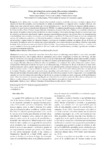El uso de la bicicleta en la escuela: una revisión sistemática

View/
Use this link to cite
http://hdl.handle.net/2183/36661
Except where otherwise noted, this item's license is described as Creative Commons Attribution-NonCommercial-NoDerivs 4.0 International License (CC-BY-NC-ND 4.0)
Collections
- Investigación (FCS) [1295]
Metadata
Show full item recordTitle
El uso de la bicicleta en la escuela: una revisión sistemáticaAlternative Title(s)
The use of bicycles at school: a systematic reviewDate
2024-03-29Citation
Canosa Pasantes, F., Arufe Giráldez, V., & Navarro-Patón, R. (2024). El uso de la bicicleta en la escuela. Una revisión sistemática (The use of bicycles at school. A systematic review). Retos, 55, 78–87. https://doi.org/10.47197/retos.v55.103584
Abstract
[Resumen] En los últimos años los centros educativos han mostrado su interés en abordar contenidos vinculados a algunos de los objetivos de desarrollo sostenible, como la educación de calidad, la sostenibilidad y/o transporte activo o la salud y bienestar. Este trabajo tiene como principal objetivo realizar una revisión sistemática sobre el uso de la bicicleta en educación infantil, primaria y secundaria. Se siguieron las recomendaciones del protocolo PRISMA. Se analizaron las publicaciones científicas indexadas en un total de 8 bases de datos (Web of Science, Scopus, Phsycinfo, Dimensions, Pubmed, Scilit, Lens y Dialnet). Los resultados confirman un bajo número de estudios de intervención con bicicletas en centros escolares. Con relación a la etapa educativa se encontró que el uso de la bicicleta en Educación Infantil puede conllevar una mayor oportunidad para practicar más actividad física y se constatan mejoras en las habilidades motrices básicas (locomoción, control de objetos y equilibrio). En Educación Primaria, se reportan resultados del aumento del rendimiento académico y en Educación Secundaria se constaron resultados como el aumento del gasto energético y la aptitud aeróbica. Algunos trabajos en Educación Primaria y en Educación Secundaria confirman un aumento del uso de la bicicleta como medio de transporte activo. Se concluye que en la actualidad hay pocos centros educativos que utilicen la bicicleta como medio de trabajo de la competencia motriz en las clases de Educción Física. Son necesarias más intervenciones del uso de la bicicleta en la escuela y analizar los efectos que podría producir en diferentes variables del desarrollo humano, sociedad y especialmente vinculadas a los objetivos de desarrollo sostenible. [Abstract] In recent years, educational centers have shown their interest in addressing content linked to some of the sustainable development objectives, such as quality education, sustainability and/or active transportation or health and well-being. The main objective of this work is to carry out a systematic review on the use of bicycles in early childhood, primary and secondary education. The recommendations of the PRISMA protocol were followed. Scientific publications indexed in a total of 8 databases (Web of Science, Scopus, Phsycinfo, Dimensions, Pubmed, Scilit, Lens and Dialnet) were analyzed. The results confirm a low number of intervention studies with bicycles in schools. In relation to the educational stage, it was found that the use of the bicycle in Early Childhood Education can lead to a greater opportunity to practice more physical activity and improvements are observed in basic motor skills (locomotion, control of objects and balance). In primary education, results of increased academic performance are reported and in Secondary Education, results such as increased energy expenditure and aerobic fitness were recorded. Some works in Primary Education and Secondary Education confirm an increase in the use of bicycles as a means of active transportation. It is concluded that currently there are few educational centers that use the bicycle as a means of working on motor competence in Physical Education classes. More interventions are necessary regarding the use of bicycles in school and to analyze the effects that it could produce on different variables of human development, society and especially linked to sustainable development objectives.
Keywords
Infancia
Niñez
Educación física
Bicicleta
Bici
Escuela
Chilhood
Early childhood education
Physical education
Bike
Bycicle
School
Niñez
Educación física
Bicicleta
Bici
Escuela
Chilhood
Early childhood education
Physical education
Bike
Bycicle
School
Editor version
Rights
Creative Commons Attribution-NonCommercial-NoDerivs 4.0 International License (CC-BY-NC-ND 4.0)
ISSN
1579-1726






